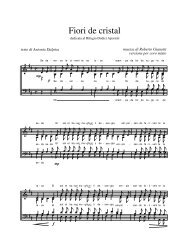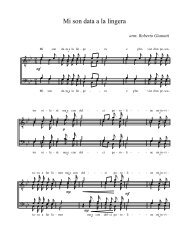Latin texts and notes - Gianotti Roberto
Latin texts and notes - Gianotti Roberto
Latin texts and notes - Gianotti Roberto
You also want an ePaper? Increase the reach of your titles
YUMPU automatically turns print PDFs into web optimized ePapers that Google loves.
the choices made by the composer.<br />
Sacred compositions like the Vespers of the Blessed Virgin are first <strong>and</strong> foremost expressions of prayer, devotion<br />
<strong>and</strong> introspection, but we must not overlook the two decisive aspects which help us to underst<strong>and</strong> the indication<br />
of the slow tempi. The first is the solemnity of the pieces: liturgical, textual <strong>and</strong> dramatic solemnity of<br />
the <strong>texts</strong> of the psalms <strong>and</strong> hymns, solemnity representing the Church as an institution <strong>and</strong> solemnity of the<br />
Word. Just as the pronunciation of an actor in the theatre makes use of support of the syllables <strong>and</strong> of the voice<br />
itself so that the sound, when it is not artificially amplified, can carry <strong>and</strong> be heard throughout the theatre – a<br />
manner of speaking that is different from everyday speech, almost unnatural – thus the oration of a celebrant<br />
in church, again if it is to be heard without the assistance of artificial amplification, must be clear <strong>and</strong> well<br />
marked, <strong>and</strong> therefore also slower. In the same way, in the acoustics of a church, the sung word too requires a<br />
tempo that is appropriate to the acoustic context <strong>and</strong> to the sacred character of the text not only so that it<br />
may be heard but also so that it may have the time to impress on the listener’s soul the sentiment that the<br />
music seeks to provoke 3 . Rhetoric thus becomes the most efficient means to represent, persuade, communicate<br />
<strong>and</strong> colour both the spoken text <strong>and</strong> the song. Gestures are emphatic, the colours of the voice highly contrasting<br />
<strong>and</strong> the tempi extended. It was always so in earlier times, until technology produced a more modern system<br />
which has replaced rhetoric. We need only listen again to the older recordings of old theatre actors, or look at<br />
the rare films of celebrations, liturgies <strong>and</strong> speeches of past ages, to underst<strong>and</strong> just how far removed from our<br />
sensibility is the way of speaking <strong>and</strong> the use of gesture, <strong>and</strong> to underst<strong>and</strong> too that the music of the past was<br />
born in a context of Rhetoric <strong>and</strong> Emphasis which we musicians must necessarily take into consideration.<br />
We may add the age-old question of transposition of musical works written in the high clefs which, if it is not<br />
applied by the performer, leads to performances of much of the early-music repertoire that are based on a mistaken<br />
reading <strong>and</strong> are out of tune: the sopranos sing coloratura, the tenors push the high <strong>notes</strong> <strong>and</strong> become<br />
contraltos, the basses are tenors, <strong>and</strong> the whole piece is played <strong>and</strong> sung a fourth or a fifth above the tone<br />
which the composer intended. It is as though Beethoven’s Ninth Symphony were played a fourth higher, shifted<br />
from D minor to G minor. In the 1610 collection, the Mass In illo tempore, the Lauda Jerusalem <strong>and</strong> the two<br />
Magnificats, in fact, need to be transposed down a fourth compared to the <strong>notes</strong> indicated in the score, in line<br />
with a practice codified <strong>and</strong> indicated in all the treatises of the age 4 .<br />
Ornamentation<br />
The art of ornamentation likewise belongs to the expressive world of Rhetoric <strong>and</strong> is subject to its rules. The<br />
music contained in ornamentation treatises represents its true heritage. Fanciful ornaments, melodic patterns,<br />
compositions created to embellish “st<strong>and</strong>ard” melodic fragments, that is to say those subjects that can be recognised<br />
in all the pieces we perform <strong>and</strong> can be found, identical, in the treatises. It is a mistake to consider sixteenth<br />
<strong>and</strong> seventeenth-century treatises as theoretic works, for this precludes knowledge <strong>and</strong> enjoyment of the great<br />
quality of fine music they contain for us performers. This is what happens in architecture treatises, where the<br />
friezes <strong>and</strong> decorations printed are models destined to decorate, for example, doors <strong>and</strong> windows of bare buildings:<br />
subjects which, without the ornaments, are simply functional, repetitive openings in the walls.<br />
The doors <strong>and</strong> windows in music are the long <strong>notes</strong> which alone do not seek to express the feeling of the words<br />
but wait, to acquire meaning, for the performer to apply the necessary ornaments. One example among many:<br />
Audi – Listen (“Listen to my voice, my song that invokes you”), Coelum – Heaven (the ornament depicts in the<br />
eyes of the listener the heaven contemplated by the praying voice), Verba Mea – My words (an expression which<br />
here means the sung word, my song).<br />
The words of the motets wish to be illustrated in order to become real images: through the use of ornaments,<br />
these images can now evoke <strong>and</strong> represent the forms <strong>and</strong> the colours signified by the word <strong>and</strong> amplify the<br />
very expression of the song <strong>and</strong> the voice.<br />
The ornamentations present in this recording are the work of musicians of Monteverdi’s time (Richardo <strong>and</strong><br />
Francesco Rognoni, Giovanni Battista Bovicelli, Bartolomeo Barbarino, Antonio Brunelli), music created to decorate<br />
“typical” subjects, like those found in the Vespers. Their application brings astonishing surprises <strong>and</strong> might make<br />
today’s performances, like those of the past, very personal <strong>and</strong> diversified, never the same <strong>and</strong> like one another.<br />
11














